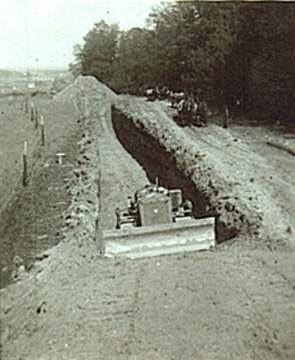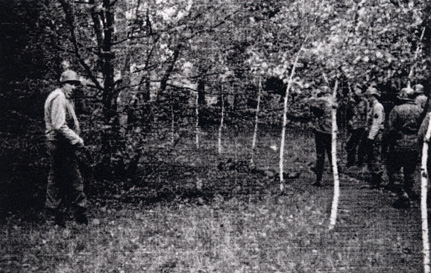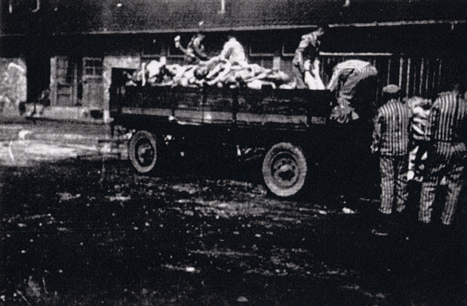40th Combat Engineer Regiment at Dachau

Pile of bodies in front
of the Dachau crematorium, May 1945
Photo Credit: Donald
E. Jackson, 40th Combat Engineer Regiment
On April 30, 1945, the day after the
Dachau concentration camp was liberated, the 40th Combat Engineer
Regiment, which was supporting the 45th Thunderbird Division,
arrived to take over in the aftermath of the liberation. The
soldier in the photo above is Eldon Patterson of E Company, 40th
Combat Engineers. In the background is a pile of naked dead bodies,
stacked up outside the crematorium. Behind the bodies is Baracke
X, the crematorium building, with a wooden structure attached
to the brick building. This structure, which has long since been
removed, was mentioned in the Chavez Report, written by a US
Army officer, after the liberation of Dachau. This report, which
was subsequently entered into the Nuremberg International Military
Tribunal as Documents 159L and 2430-PS, stated that this structure
was a "Wooden shed believed to contain a pump or compressor."
Two German civilians are shown on the
left in the photo above. According to Donald E. Jackson, who
took this photo in May 1945, "We used civilian wagons to
haul the bodies and you can see them in other photos. The civilians
loaded the bodies and unloaded them into the trench."
The photograph below shows the digging
of a trench for a mass grave on the hill called Leitenberg, located
a short distance outside the Dachau camp. The trenches were dug
with bulldozers by the men of the 40th Combat Engineer Regiment,
and German civilians were forced to bury the bodies.

US Army bulldozer digging
trench for mass graves at Leitenberg
Photo Credit: Donald
E. Jackson, 40th Combat Engineer Regiment
The photograph below shows soldiers from
the 40th Combat Engineer Regiment as they search the area around
the Dachau camp for dead bodies. The soldier on the left is T5
John Bechtold.

Searching for bodies
at Dachau after the liberation
Photo credit: Donald
E. Jackson, 40th Combat Engineer Regiment
The men of E Company had the unpleasant
task of getting rid of the corpses that were piled up in the
camp; the Germans had run out of coal to burn the bodies, so
the corpses had accumulated in the last days before the camp
was liberated. Since October 1944, the Germans had been burying
the bodies in mass graves on a hill called Leitenberg.
Dachau residents were forced to bury
some of the decomposing bodies from the camp in individual graves
in the town cemetery named Waldfriedhof. The American liberators made
sure that everyone in Dachau knew the enormity of the atrocities
in the camp by forcing Dachau farmers to haul the bodies by a
circuitous route through the town on their way to the Leitenberg
cemetery.
In the month of May 1945, there were
2,226 former inmates of the Dachau concentration camp who died
of typhus and other diseases in spite of the excellent medical
care given to them by the US Army doctors. An additional 196
former prisoners died in the month of June 1945 before the typhus
epidemic could be brought under control. Some of the victims
who died after the liberation were cremated in the ovens at Dachau,
while others were buried in unmarked graves, even though their
names were known. Approximately 7,500 Dachau prisoners are buried
at Leitenberg, including those buried by the Germans before the
liberation and 5,380 who were buried afterwards by the Americans.
The photograph below shows the bodies
that were piled up in front of the crematorium, as they are being
loaded onto wagons by some of the former inmates at Dachau. Even
after they were liberated, the prisoners had to stay inside the
camp and they were put to work, supervising the removal of the
bodies of their comrades for burial.

Liberated prisoners
load bodies onto wagons
Photo credit: Donald
E. Jackson, 40th Combat Engineer Regiment
The photograph below, which was also
contributed by Donald E. Jackson, shows German civilians unloading
bodies from a wagon and placing them in a mass grave dug by the
bulldozer. The Germans were ordered to wear their best clothes
to show respect for the dead.

German civilians burying
bodies at Leitenberg
Photo credit: Donald
E. Jackson, 40th Combat Engineer Regiment
Burial
of Bodies at Dachau
Dachau
citizens brought to Camp
Dachau
residents forced to bring food
Typhus epidemic
at Dachau
Old
photos taken after the liberation
Back to Dachau
Liberation
Back to Table
of Contents
Home
40th Combat Engineer Regiment at Dachau On April 30, 1945, the day after the Dachau concentration camp was liberated, the 40th Combat Engineer Regiment, which was supporting the 45th Thunderbird Division, arrived to take over in the aftermath of the liberation. The soldier in the photo above is Eldon Patterson of E Company, 40th Combat Engineers. In the background is a pile of naked dead bodies, stacked up outside the crematorium. Behind the bodies is Baracke X, the crematorium building, with a wooden structure attached to the brick building. This structure, which has long since been removed, was mentioned in the Chavez Report, written by a US Army officer, after the liberation of Dachau. This report, which was subsequently entered into the Nuremberg International Military Tribunal as Documents 159L and 2430-PS, stated that this structure was a "Wooden shed believed to contain a pump or compressor." Two German civilians are shown on the left in the photo above. According to Donald E. Jackson, who took this photo in May 1945, "We used civilian wagons to haul the bodies and you can see them in other photos. The civilians loaded the bodies and unloaded them into the trench." The photograph below shows the digging of a trench for a mass grave on the hill called Leitenberg, located a short distance outside the Dachau camp. The trenches were dug with bulldozers by the men of the 40th Combat Engineer Regiment, and German civilians were forced to bury the bodies.  The photograph below shows soldiers from the 40th Combat Engineer Regiment as they search the area around the Dachau camp for dead bodies. The soldier on the left is T5 John Bechtold.  The men of E Company had the unpleasant task of getting rid of the corpses that were piled up in the camp; the Germans had run out of coal to burn the bodies, so the corpses had accumulated in the last days before the camp was liberated. Since October 1944, the Germans had been burying the bodies in mass graves on a hill called Leitenberg. Dachau residents were forced to bury some of the decomposing bodies from the camp in individual graves in the town cemetery named Waldfriedhof. The American liberators made sure that everyone in Dachau knew the enormity of the atrocities in the camp by forcing Dachau farmers to haul the bodies by a circuitous route through the town on their way to the Leitenberg cemetery. In the month of May 1945, there were 2,226 former inmates of the Dachau concentration camp who died of typhus and other diseases in spite of the excellent medical care given to them by the US Army doctors. An additional 196 former prisoners died in the month of June 1945 before the typhus epidemic could be brought under control. Some of the victims who died after the liberation were cremated in the ovens at Dachau, while others were buried in unmarked graves, even though their names were known. Approximately 7,500 Dachau prisoners are buried at Leitenberg, including those buried by the Germans before the liberation and 5,380 who were buried afterwards by the Americans. The photograph below shows the bodies that were piled up in front of the crematorium, as they are being loaded onto wagons by some of the former inmates at Dachau. Even after they were liberated, the prisoners had to stay inside the camp and they were put to work, supervising the removal of the bodies of their comrades for burial.  The photograph below, which was also contributed by Donald E. Jackson, shows German civilians unloading bodies from a wagon and placing them in a mass grave dug by the bulldozer. The Germans were ordered to wear their best clothes to show respect for the dead.  Burial of Bodies at DachauDachau citizens brought to CampDachau residents forced to bring foodTyphus epidemic at DachauOld photos taken after the liberationBack to Dachau LiberationBack to Table of ContentsHome |